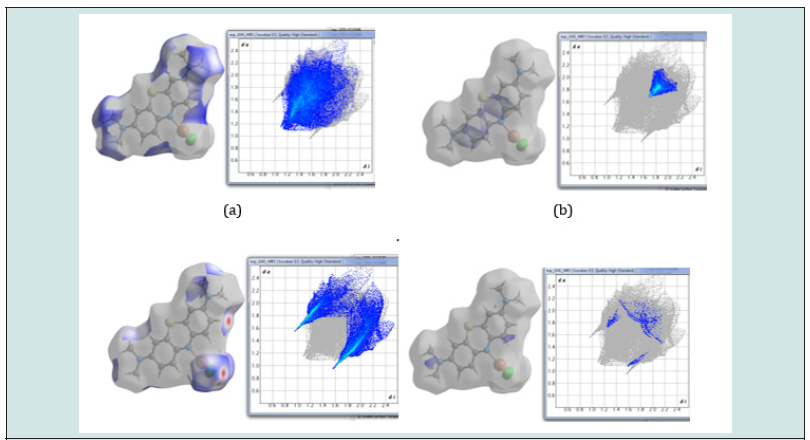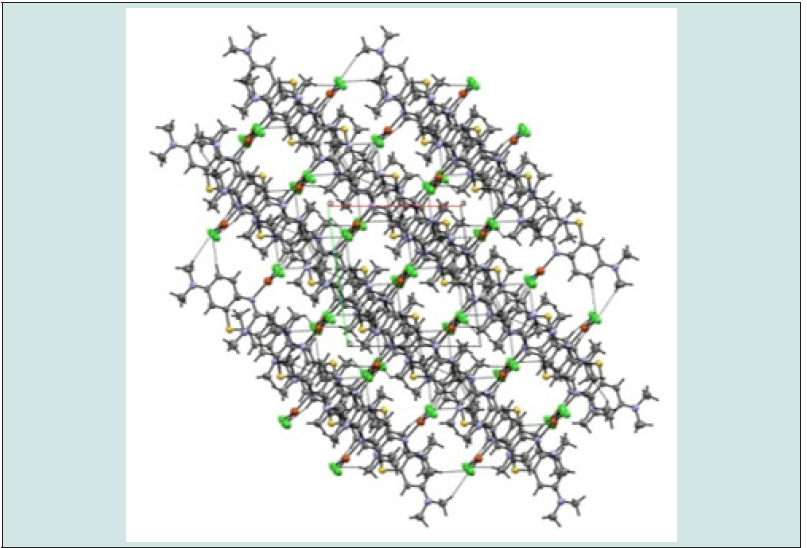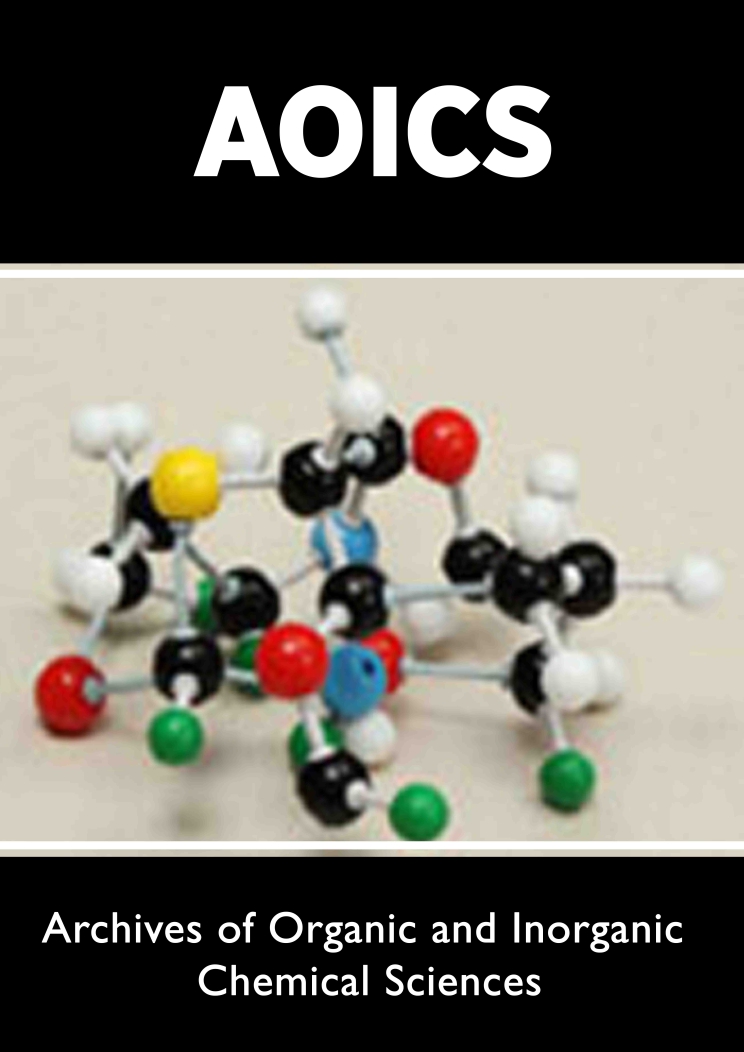
Lupine Publishers Group
Lupine Publishers
Menu
ISSN: 2637-4609
Research Article(ISSN: 2637-4609) 
The Hirshfeld Surface and Fingerprint Plot Analysis of Weak Interactions in The Crystal Structure of Trimeric Complex of Coper(I) Dichloride with Methylene Blue Volume 5 - Issue 5
Vahobjon Kh Sabirov*
- Pharmaceutical Institute of Education and Research, Tashkent, Uzbekistan, Russia
Received:September 4, 2023; Published:September 12, 2023
*Corresponding author:Vahobjon Kh Sabirov, Pharmaceutical Institute of Education and Research, Tashkent, Uzbekistan, Russia
DOI: 10.32474/AOICS.2023.05.000223
Abstract
Crystals of (I) is monoclinic, space group is P21/n, a=15.1327(5), b=14.9456(3), c=16.5175(5) Å, = 115.236(4), Z=4. Complex (I) is built from trimeric molecule [Cu (Mb)Cl2] linked through ππ interactions. The intermolecular short contacts in the trimeric complex [Cu (Mb)Cl2] (I) (where Mb is methylene blue, methylthioninium cation) were studied by the Hirshfeld surface and fingerprint plot analysis. The 2D fingerprint plots confirmed the predominance of HH (39.5 %) intermolecular interactions and while a small contribution of CC contacts (8.0 %).
Keywords: copper (I); methylene blue; π-π stacking; Hirschfeld surfaces
Introduction
Methylene blue (MB, methylthioninium chloride), a phenothiazine known for its ability to cross the blood-brain barrier and exert neuroprotective effects, is considered a potential therapy, especially for neurodegenerative diseases [1,2]. Among its beneficial properties, MB is a redox cycle stabilizer and an electron donor [1]. With the discovery of its antioxidant properties, it was proposed as a therapeutic agent in neurodegenerative and psychotic disorders with its features of mitochondrial dysfunction and redox cycle regulation. Methylene blue has been proven to inhibit the accumulation of tau proteins, which is considered among the causes of Alzheimer’s disease (AD), treat mitochondrial dysfunction with its regulating effect on the redox cycle, and to inhibit formation of ROS molecules. In given paper, the close contacts involving also π−π intermolecular interactions between MB+ cations are analyzed by using the Hirshfeld surfaces analysis.
Materials and Methods
The complex (1) was obtained in the result mechanochemical reaction of the copper (II) chloride with [MB]Cl⋅5H2O using of DMF as assistant-solvent. During reaction copper (2+) is reduced to copper (1+). Hirshfeld surfaces calculations were performed by using the Crystal Explorer 21 program [3,4].
Results and Discussions
Crystals of (1) is monoclinic, space group is P21/n, a=15.1327(5), b=14.9456(3), c=16.5175(5) Å, β= 115.236(4)°, Z=4. Molecular and crystal structures are presented in (Figures 1 & 2). The crystal structure of compound (I) is composed of the trimer consisting of the three CuCl2(MB) complexes connected mutually via π⋅⋅⋅π interactions with the mean interplanar distance 3.376 Å and close centroid-centroid distances between aromatic central rings lie in the range from 3.383 to 3.500 Å. Any type of intra- or intermolecular interactions can be demonstrated in detail by using Hirshfeld surface analysis of the crystal structure. In given paper, the crystal structure of complex (I) was studied by using of the Hirshfeld surface analysis to be visualizing the short contacts between neighboring (MB)+ cations [3]. On the dnorm surface, the red spots represent the C-H⋅⋅⋅Cl and C−H⋅⋅⋅C weak interactions acting between the middle molecule and two neighboring molecules. The blue colored area of that surface is the area which is completely free from close contacts (Figure 3). In the shape-index of the complex (I) Figure 4 convex blue regions represent hydrogen donor groups and concave red regions represent hydrogen acceptor groups in the weak interactions. As seen on this Figure, neighboring red and blue triangles confirm the existence of intermolecular interactions resulting from π-π stacking between the aromatic rings in the crystal structures of the complexes. On the 2D fingerprint plots, the blue areas show the groups of atoms involved in the close intermolecular contacts. To the right of each figure is a 2D fingerprint graph for each short contact. The 2D fingerprint plots confirmed the predominance of H⋅⋅⋅H (39.5 %) Figure 5a intermolecular interactions and while a small contribution of C⋅⋅⋅C contacts (8.0 %) Figure 5b between neighboring [MB]+ cations.
Figure 3: View of the three-dimentional Hirshfeld surface for the [MB]+ anion in the middle of trimer of the title compound plotted over dnorm.

Figure 5: 2D fingerprint plot for HH (a), CC (b), Cl…H/H…Cl (a) (29.3 %) and N…H (b) (1.5 %) contacts.

Conclusion
Close contacts in the crystal structure of trimeric complex [CuCl2(Mb)]3 were studied by using the Hirshfeld surfaces and fingerprint plots analysis. π−π stacking interaction is shown on the shape-index of the complex.
References
- Rojas J, Bruchey AK, Gonzalez-Lima F (2012) Prog Neurobiol 96: 32-45.
- Walter Sack I (2009) Eur J Clin Pharmacol 65: 179-189.
- Spackman MA Jayatilaka D (2009) Hirshfeld surface analysis, Cryst Eng Comm 1: 19.
- Turner MJ, McKinnon JJ, Jayatilaka D, Spackman MA (2011) Visualisation and characterisation of voids in crystalline materials, Cryst Eng Comm 13: 1804.

Top Editors
-

Mark E Smith
Bio chemistry
University of Texas Medical Branch, USA -

Lawrence A Presley
Department of Criminal Justice
Liberty University, USA -

Thomas W Miller
Department of Psychiatry
University of Kentucky, USA -

Gjumrakch Aliev
Department of Medicine
Gally International Biomedical Research & Consulting LLC, USA -

Christopher Bryant
Department of Urbanisation and Agricultural
Montreal university, USA -

Robert William Frare
Oral & Maxillofacial Pathology
New York University, USA -

Rudolph Modesto Navari
Gastroenterology and Hepatology
University of Alabama, UK -

Andrew Hague
Department of Medicine
Universities of Bradford, UK -

George Gregory Buttigieg
Maltese College of Obstetrics and Gynaecology, Europe -

Chen-Hsiung Yeh
Oncology
Circulogene Theranostics, England -
.png)
Emilio Bucio-Carrillo
Radiation Chemistry
National University of Mexico, USA -
.jpg)
Casey J Grenier
Analytical Chemistry
Wentworth Institute of Technology, USA -
Hany Atalah
Minimally Invasive Surgery
Mercer University school of Medicine, USA -

Abu-Hussein Muhamad
Pediatric Dentistry
University of Athens , Greece

The annual scholar awards from Lupine Publishers honor a selected number Read More...








